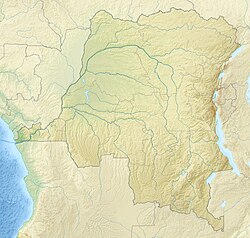Top Qs
Timeline
Chat
Perspective
Gada River (Uele)
River in Haut-Uélé, Democratic Republic of the Congo From Wikipedia, the free encyclopedia
Remove ads
The Gada River (French: Rivière Gada) is a left tributary of the Uele River, which it joins downstream from Niangara in the Haut-Uélé province of the Democratic Republic of the Congo.
Remove ads
Course
The Gada River forms to the southwest of Ndedu and flows in a generally northwest direction with many meanders to join the Uele downstream from Niangara.[1] Niangara is built on a clay plateau between the Uele and the Gada.[2] There is one large set of rapids, the Chute Itelengi.[3]
The river contains some gold, which the indigenous population extracts through artisanal methods. The river also provides a source of fish for the riverine population.[3] In the colonial era the Belgians developed some fish ponds, but these have been abandoned.[4]
Remove ads
History
A Belgian expedition led by Jules Alexandre Milz traveled by land along the south bank of the Uele selecting sites for new posts, and reached the confluence of the Gada River with the Uele on 18 March 1892, where they chose to build a new station at the village of Mbegu, named Niangara. Willem Frans Van Kerckhoven arrived there on 25 March 1892, and Jean-Hubert Cloesen was placed in charge of the post.[5]
Remove ads
Notes
Citations
Sources
Wikiwand - on
Seamless Wikipedia browsing. On steroids.
Remove ads
